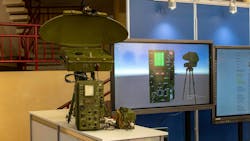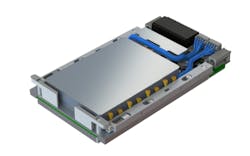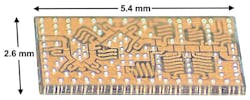Conquer the Challenges Facing Next-Gen Front Ends
What you’ll learn:
- The importance of direct RF sampling.
- Analog signal processing in direct RF front ends.
- RF miniaturization as key to direct RF adoption.
Digitization of RF signals is an important part of modern defense systems. Innovative new direct RF sampling systems promise a more simplified front-end architecture. They allow the analog-to-digital converter (ADC) to sample the RF signal directly at its original frequency without multiple stages of frequency conversion, filtering, and amplification that have burdened traditional approaches.
However, depending on the application, ensuring integrity of the signal all the way through the process to bits isn’t so simple. RF segmentation, isolation, and a cascade of analog functions still govern the performance level of any direct RF solution, albeit with fewer components than traditional architectures. The next big leap in miniaturization and simplification will need to come from the RF front end.
Antenna to Bits with Direct RF Sampling
Direct RF sampling enables the simultaneous capture of a broad spectrum of frequencies, which is essential for wideband applications. This approach can be more efficient and flexible for handling signals and facilitating advanced techniques like digital beamforming, spectrum analysis, and adaptive filtering.
Direct RF is considered the foundational building block (Fig. 1) to realize wideband, multifunction antenna-to-bit solutions. Here, the entire chain from the antenna to ADC output is optimized and designed as a cohesive system—miniature and software-definable.
While direct sampling simplifies the architecture, reduces component count, and minimizes signal degradation caused by analog processing, there are tradeoffs:
- Direct sampling artifacts: System designers using ADCs need to account for issues with dynamic range, spurious signals, and noise performance.
- Power and thermal management: High-performance ADCs can consume significant power, necessitating effective thermal-management solutions. This adds system complexity and may introduce reliability challenges if not properly managed.
- Data-processing overhead: This has kept direct sampling off the market for almost a decade. Only recently has Moore's Law delivered enough digital-signal-processing (DSP) resources to make direct sampling a competitive alternative to tunable analog architectures. Downstream resources and the power required to process the wideband digital spectrum remain a challenge for near-term adoption. For example, power consumption can be a significant challenge for lightweight unmanned aircraft systems (UAS) running on batteries.
- Signal fidelity: Despite the reduction in intermediate frequency stages, front-end design for direct RF sampling systems still needs to be carefully optimized and as flat as possible in performance across a much wider band. This includes ensuring adequate filtering and gain control to prevent aliasing as well as equalization across the entire band to make sure maximum performance out of the direct-sampling device. High-speed ADCs can be more susceptible to noise and nonlinearity, which can degrade the performance of the sampled RF signal. Achieving high signal-to-noise ratio (SNR) and spurious-free dynamic range (SFDR) is challenging and critical for maintaining system fidelity.
- Clocking: Direct RF sampling is highly sensitive to clock jitter. Any instability in the sampling clock can lead to sampling errors and degrade the quality of the digitized signal. This necessitates the use of low-jitter clock sources and architectures along with careful clock management.
- EMI/RFI: The high-frequency operation of ADCs and associated digital circuits can generate electromagnetic and radio-frequency interference (EMI/RFI), which can affect overall performance and neighboring electronic devices.
- Calibration and compensation: Direct RF sampling systems may require complex calibration and compensation techniques to correct for ADC imperfections, such as offset, gain errors, and nonlinearities. This increases system design complexity.
ADC technology and DSP continue to innovate, mitigating some of these tradeoffs. The pressure continues to be on the analog components to deliver high-fidelity signal conditioning in smaller, digital-ready packages.
Analog Signal Processing in Direct RF Front Ends
The RF front end is the initial stage of the signal-processing chain that handles the RF reception, conditioning, and distribution, rejecting unwanted signals and noise as well as converting signals of interest to a format that can be further processed and channelized by the system. Key components typically include antennas, filters, low-noise amplifiers, mixers, local oscillators, automatic gain control, power amplifiers, and, finally, switches and duplexers.
Direct sampling bypasses the need for mixers and to some extent, filtering—at least narrowband filtering, which can be done entirely in the digital domain. Filtering to eliminate interference, intentional or otherwise, is another story.
The design and the dynamic performance of the RF front end directly affects the quality and integrity of the direct-sampled spectrum. The holy grail of a direct-sampling RF front end would be the ability to notch-out unwanted, arbitrary signals. Since even the best filtering technology induces some signal loss, amplification takes on additional importance from receive to transmit.
The ability to seamlessly manage the spectrum across different frequency domains with respect to selective filtering, amplification and, for even higher-frequency applications, block up/downconversion, is a potential game-changer for future direct-sampling solutions.
Other intrinsic limitations to ADCs can be more problematic with direct sampling. More bandwidth is generally commensurate with a higher noise floor, and it can reduce the range and/or sensitivity of a direct-sampling solution.
To be economically competitive with narrower-band, analog-oriented approaches, direct-sampling devices need to maximize the number of channels and benefit from new miniaturized RF front ends to offset ADC signal-handling challenges. RF miniaturization is complex and multifaceted due to several technical and physical limitations. The good news is that with direct sampling, fewer RF components need to be minimized.
Challenges and Solutions to RF Front-End Miniaturization
Segmentation and isolation
Segmentation and isolation are not equivalent. Achieving RF isolation in the real world is fundamentally about the physics of the RF circuit. As the complexity of the RF functions is comparatively low to a complex piece of modular software, the easiest and most cost-effective approach is to make segmentation and isolation key parameters of the RF design and manufacturing process.
New system-in-package (SiP) platforms (Fig. 2) leverage advances in simulation to incorporate isolation techniques into the electromagnetic simulation of the RF cascade. The design approach decomposes the manufacturing capabilities, models them in simulation, and then uses simulation tools to adjust the level of miniaturization.
Material science
The materials used in RF components must have precise electrical properties to ensure proper signal transmission and reception. Finding suitable materials for high frequency that are compatible with miniaturization is a significant challenge.
Discovering and manufacturing new materials that can advance the state-of-the-art in filter miniaturization and/or tunable filters is a key focus of the RF industry. Simulation can also play an important role in extending the RF performance of existing materials. Two of the most promising are glass substrates and advances in surface-mount technologies for components up through Ka-band. Figure 3 shows an example.
Reusability and scalability
Though not generally associated with RF, a building-block approach combined with 3D electromagnetic simulations makes it possible to optimize circuit designs for reuse. And every reuse is an opportunity to re-optimize these blocks. Factoring footprint-driven factors into the simulation process allows for reuse and scaling into future devices.
RF integration
Integrating RF devices into digital systems has rarely been plug-and-play. The integrator needs to build control circuitry while accounting for device parasitics. Components that have embedded control, such as a digital gateway, and standard manufacturing rules can greatly ease the burden of integration. As direct sampling devices move the digital line deeper into traditional front ends, RF devices with integrated digital control can remove the need to add single-board computers and operating systems.
Testing and calibration
Testing and calibrating miniaturized RF components and systems is more challenging due to their small size and high frequency of operation. Specialized equipment and techniques are often required to ensure accurate measurements and performance. Embedding extremely small FPGAs into RF SiPs for on-board and in-band testing allows for RF functions to be smaller than is possible with test-and-tune.
Power consumption
Achieving low power consumption is critical in miniaturized devices, especially for battery-operated systems. Balancing performance with power efficiency in a small footprint requires innovative design and optimization techniques. RF SiPs offer a unique opportunity to move the thermal architecture closer to the components.
Antennas
The choice of antenna drives the entire architecture and can impact the level of miniaturization required. Downstream RF is typically optimized once the antenna is chosen.
Overcoming Challenges Facing Next-Gen Front Ends
The evolution of semiconductor technology has led to high-performance ADCs with increased speed and resolution, reducing the size, weight, and power requirements for digital signal processing. Direct RF sampling reduces complexity by sampling RF signals directly, moving much of the frequency processing to software, and facilitating more efficient spectrum usage. This enables more efficient and compact RF systems.
However, while it simplifies architecture and lowers component count, challenges include power consumption, thermal issues, data-processing overhead, front-end design, clock jitter sensitivity, EMI/RFI, and calibration.
The future of front-end miniaturization hinges on developing next-generation RF front ends—analog co-processors to complement direct sampling and mitigate system design and performance challenges. This is no small task. This new generation of small-footprint RF front ends must focus on segmentation, isolation, materials, reuse, scalability, RF integration, testing, calibration, and power efficiency. New materials, simulation techniques, modularity, and integrated digital control are key to overcoming these challenges.



